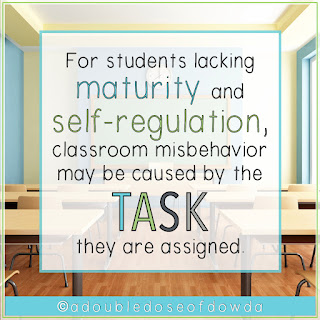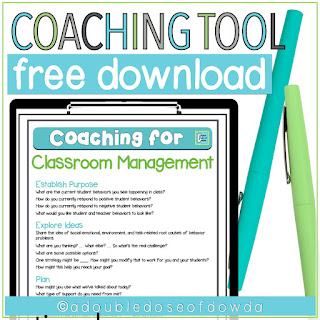Any teacher knows the value of having strong classroom management skills, but what do you do if you are an instructional coach who is trying to support other teachers with behavior management strategies?
I have an unofficial theory that the cause of most classroom behavior problems comes from one of three root causes. Let’s think of these root causes as three buckets: the social/emotional bucket, the environmental bucket, and the task bucket.What to look for in this post:
- The root causes of behavior problems in the classroom: social / emotional, environment, task
- A coaching session I would do with teachers about classroom management
If you prefer to hear me talk through this, here is a video featuring all of this content:
[1:15] The social/emotional bucket for behavior problems in the classroom
In the social/emotional bucket, students’ behavior problems may be rooted in their physical needs being unmet. Maybe they aren’t getting enough sleep, or enough food in their bellies. If these needs aren’t met, their behavior will not be appropriate for the classroom.Students may also fall into this bucket because they are seeking attention - either from their peers or from the teacher. It might make them feel more powerful to get attention from others in the classroom.
In addition, students may be experiencing pain and they are taking it out on others. Sometimes students’ aggressive behaviors can be rooted in anger that stems from other areas in their lives.
[2:27] The environment bucket for behavior problems in the classroom
In the environment bucket, students’ behavior problems may be related to inconsistency in rules, procedures, and routines within the classroom itself. Maybe there are extra long transition times, or the pacing is off in the classroom. When students do not know what they are supposed to be doing, they fill the time doing whatever they want to do.Poor proximity may also relate to behavior problems, as the number one thing a teacher can do to improve student engagement is to be physically closer to them. If a teacher stands at the front of the room and a misbehaving student is in the back, that lends itself to behavior problems.
[3:37] The task bucket for behavior problems in the classroom
In the task bucket, students’ behavior problems are rooted in unclear expectations of the task demands. Sometimes teachers can give a long list of directions, and then get upset when the students cannot meet all of the expectations.In addition, it could be that the task itself is not engaging or that the task is not at the right level for the student. If tasks are too easy or too difficult, that can be associated with behavior problems. More scaffolding may be necessary if the students’ skills are not at the appropriate level for the task.
For students who don’t have the maturity and the self-regulation, the task bucket is very possibly a problem that is causing more student misbehavior.
[6:15] A step-by-step instructional coaching session for teachers struggling with classroom behavior problems
If you are a teacher experiencing behavior problems in your classroom, you can pause after every question and make some notes for yourself. If you are an instructional coach, I want you to go through this one time as I explain my thinking. At the end, I am going to tell you how you can get a one-page printout of these questions for you to use in conversations with teachers.With every teacher meeting, I always establish the purpose of the meeting. We then explore ideas, make a plan, determine our evidence, talk about next steps, and reflect on how the meeting went.
[8:25] Establish the purpose of the instructional coaching session
The first thing I want to do whenever I meet with a teacher is to establish the purpose for our meeting. I want to know where they are coming in, and where they want to be leaving the meeting.[8:38] The questions I would ask in an instructional coaching session about classroom behavior problems
The first thing I want to know is where the student behaviors are happening in the classroom.Then, I want to know how the teacher responds to both positive and negative behavior in her classroom.
In addition, I ask teachers about what they would like behavior to look like in the classroom - both that of the students and of the teacher. Now I know how the teacher is responding as well as how the teachers would like behavior to look. Hopefully we are planting the seeds for the teacher to understand that, in order for student behavior change to occur, teacher behavior change probably has to occur as well.
[10:04] Exploring ideas about strategies for behavior management
The next section of my protocol involves exploring ideas. I would share with the teacher about the three buckets, and I would ask them to think about which of these root causes they see in their classroom. I will then ask, “What else?” I really want to encourage them to dig deeper and have some thoughtful responses. I might have to ask this a couple more times before getting to the next question about the real challenge going on. Sometimes the first thing you think is the problem really is, but other times it’s not. We want to go a few layers deeper and get a clear sense of the challenges going on.Once we identify the challenges, then we can talk through some solutions. If I feel like the teacher is open to it, I can suggest a strategy I have in mind that I think would fit their teaching style. It is important to ask if you can share it, and it is also important to keep the suggestion brief. After you provide a suggestion, you can then ask them how they could modify it to fit their needs and their classroom. As a coach, you are not in their classroom every day and you do not know everything happening in that space. Giving them the opportunity to modify what you share, no matter how great you think it is, is empowering for them.
Next, you can discuss with the teacher how this idea might help them to reach their original goals mentioned when establishing the purpose of the meeting.
[13:05] Making a plan to address behavior problems in the classroom
The third section of my protocol is to create a plan. The teacher and the coach can work together to figure out how the teacher can use what you have discussed. Then, discuss the support that the teacher feels they need from you as the coach. Maybe they need to see something modeled, or they want you to co-teach a lesson with them. They might want extra articles or research about a strategy. Whatever it is, leave the door open to engage in a partnership. You are in this together, and the teacher needs to know they have your support.[14:33] Gathering evidence about classroom behavior management strategies
This part of the protocol often gets overlooked. The first question in this section is, what evidence will we collect to determine if our plan was successful? You can discuss whether or not it would be appropriate for you as the instructional coach to observe in the classroom. If the behavior we are trying to break is how often the teacher has to stop instruction in order to correct behaviors, I can go in as the coach and tally how often instruction is interrupted. As the teacher implements some new strategies, we would hope to see fewer and fewer of those tallies.Going into the second question when it comes to evidence, we want to know how to determine success. If the baseline shows that the teacher has to interrupt their instruction 20 times per lesson, maybe a good goal would be to aim for 10 times. Once they are meeting that consistently, maybe the next step can be even lower. Start with a goal that is easier to meet, and then continue to improve.
[17:06] Next steps and reflection
The final component of my instructional coaching protocol is talking about next steps and reflection. I ask the teacher to talk to me about their action plan: what are they going to do, what am I going to do, and what are we going to do together?It is easy to skip over and forget to ask teachers, but lastly I ask them to reflect on the coaching session. I want to know what was most helpful to them. You can first run down all the things you did together or discussed, or have the teacher summarize the session as well.
[18:30] FREE list of questions: Coaching for Classroom Management
I have a free list of every question that I asked and all my sections are there as well. Coaches or teachers can stick this in a lesson plan book and reflect on it from time to time. If behavior problems come up again, you can ask yourself these questions and go through and coach yourself.Click here to access the Coaching for Classroom Management Guide FREEBIE:
https://view.flodesk.com/pages/5fc97dca132c2d4b127c9e00Looking for more instructional coaching resources?
You can join our monthly instructional coaching email list for free resources and tips.My Instructional Coaching Time Tracking Tool is available on Teachers Pay Teachers.
The Classroom Management Behavior Plan is available on Teachers Pay Teachers.
Check out these related posts:
Instructional Coach Interview Tips
7 Tips for Becoming an Instructional Coach
What Are the Instructional Coaching Requirements?
Suggested Reading to Prepare for an Instructional Coach Interview
Instructional Coaching in 5 Words
4 Tips for a New Instructional Coach
Check out these related YouTube videos:
How to Become an Instructional Coach: Definition & Qualifications
7 Tips for How to Become an Instructional Coach
Suggested Reading to Prepare for Instructional Coaching
Instructional Coaching Video Playlist
Check out these related posts:
Instructional Coach Interview Tips
7 Tips for Becoming an Instructional Coach
What Are the Instructional Coaching Requirements?
Suggested Reading to Prepare for an Instructional Coach Interview
Instructional Coaching in 5 Words
4 Tips for a New Instructional Coach
Check out these related YouTube videos:
How to Become an Instructional Coach: Definition & Qualifications
7 Tips for How to Become an Instructional Coach
Suggested Reading to Prepare for Instructional Coaching
Instructional Coaching Video Playlist





No comments
Post a Comment